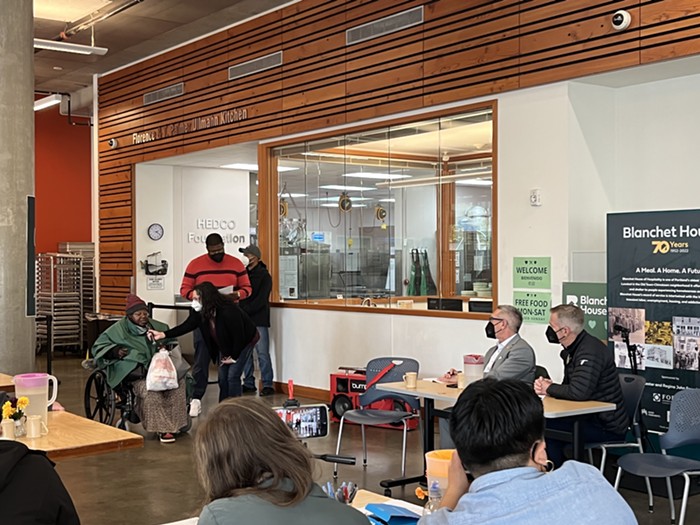SOME SAY it's not the healthiest thing, but I cannot resist a good opportunity to multitask. Taking a hike for exercise and fresh air is lovely unto itself, but if I can add value to the experience by also procuring food or other useful stuff, then all the better.
Lately, young entrepreneurs in the Portland area have taken an interest in wildcrafting, in which they head to various parts of the region—the sea, the desert, the mountain woods—to procure herbs and other plants to be used for food, medicine, and toiletries. Kristen Dilley and Elie Barausky are some of the most successful among them. Their Portland Apothecary (portlandapothecary.com) line of soaps, teas, balms, scrubs, and more can be found in some of the city's better boutiques, and they even offer a seasonally appropriate CSH—like a CSA, but "community-supported herbalism" instead of "agriculture."
If you're ready to test out a bit of wildcrafting yourself, instead of just enjoying the fruits of others' foraging, Dilley gave a few tips about how to get started, and how to harvest responsibly from the wild.
MERCURY: How did you become interested in wildcrafting, and how did Portland Apothecary develop?
KRISTEN DILLEY: Even when I was a child I would spend a lot of time foraging around in the woods, putting together potions and secret bundles while my family was camping. At that point it was more about the dreamy romance of make-believe, but through the years I've paid close attention to the plants that grow around me. At this point I've been practicing Western herbalism for over a decade and am also a licensed acupuncturist (Nightingale Acupuncture, nightingaleacupuncture.wordpress.com). Elie grew up on a biodynamic farm steeped in the rich culture of working with the land. We met through a mutual friend and hit it off. Elie had a soap company at that time, and I had an idea for an herbal CSA project, and quickly tea at Fresh Pot became a business that is now going into its third year. We not only have a CSH based on seasonal medicine, but also a wholesale line, an online shop, and you can find us at pop-up shops like Rejuvenation's Sunday Emporium or Palace. We even teach a class on seasonal medicine, where we take people into the woods and show them how to make medicine at Wildcraft Studio School (wildcraftstudioschool.com). We've also been doing custom blends for Icon Tattoo and Lowell.
What sorts of plants are easy to forage during the Pacific Northwest summer?
The Pacific Northwest is truly amazing in its plant diversity and abundance. That being said, we are conservative and protective of the flora and fauna in the area. The increased attention and interest in herbalism is wonderful, but we need to keep in mind that, like anything else, it is a limited resource.
Some great beginner plants that are in great abundance and have a good general use are St. John's wort, mullein, yarrow, Douglas fir, and cedar. You can also hunt for huckleberries, and of course you can always find blackberries around the edges of any woodland.
Where are the best areas to look?
Herbs are growing all around us here in the city, as well as in the forests, mountains, and coastal areas. We only forage and wildcraft for personal use, or for making remedies that are extremely low impact on the environment, like flower essences. The bulk of the herbs we work with [for Portland Apothecary] are farmed or found in the garden, but when we go out to harvest we often go out to the coastal range. Or we might drive east over Mount Hood and visit with some of our favorite desert herbs.
You will find that once you get to know the plants around you, the entire landscape will change. I often marvel when I stand still in one place at how many aspects of our health can be addressed by one little patch of land. I would suggest learning a couple plants at a time and really understand them by integrating them into your daily life, and then get to know a couple more.
What are some guidelines for foraging without causing too much disruption to the environment?
It's really important to get to know the area that you'll be harvesting from before you actually harvest. Ask yourself the following questions: Do the plants look healthy? Are the plants plentiful? Does it look like someone was just harvesting there? Have you properly identified the plant? Is the area free of pesticides or agricultural waste? Are you harvesting only what you need? Can the ecosystem support the loss of what you are gathering?
It is common for many herbalists who wildcraft to take care of a grouping, or stand, of plants over time. They may replant as they harvest, by burying sections of the plant's roots, or they may reseed the area. It is important to establish a relationship with the land where you not only take, but also give back. We cannot stress enough that plenty of plants look very similar—you really, really want to make sure you are identifying them correctly before you harvest them. There are great identification books out there, and a lot of herb ID walks led by seasoned herbalists.
Once you've harvested, what are some easy ways to make use of your herbs?
St John's wort makes a beautiful oil if you collect the buds, slightly bruise them, and let them infuse in oil in the sun for a few weeks. Mullein is a great herb to harvest for its leaves, which you can dry and use for respiratory problems later in autumn—or you can use its flowers infused in oil for earaches. Yarrow can also be collected and dried for a bitter, yet effective tea for feverish colds in autumn and winter. Douglas fir and cedar tips can be great to harvest when you're camping. Ideally you would harvest tips in the spring, but summer can be fine too. They make a great, lemon-flavored tea that is high in vitamin C, so it's a great camping treat!
What are some good resources to use to get started?
We teach at Wildcraft Studio School in White Salmon, Washington, but there are also great schools and classes offered in town. There is the annual Portland Plant Medicine Conference (pdxplantmedicine.org), where you can meet a variety of makers and teachers if you are just starting out. There's the Elderberry School (elderberryschool.com), and the Arctos School (arctosschool.org) as well, if you are looking for a longer, in-depth program. Authors we love include Michael Moore, the Peterson Field Guide, Gregory Tilford's ID books, and of course anything by Rosemary Gladstar for great recipes to use all of those wonderful plants!













